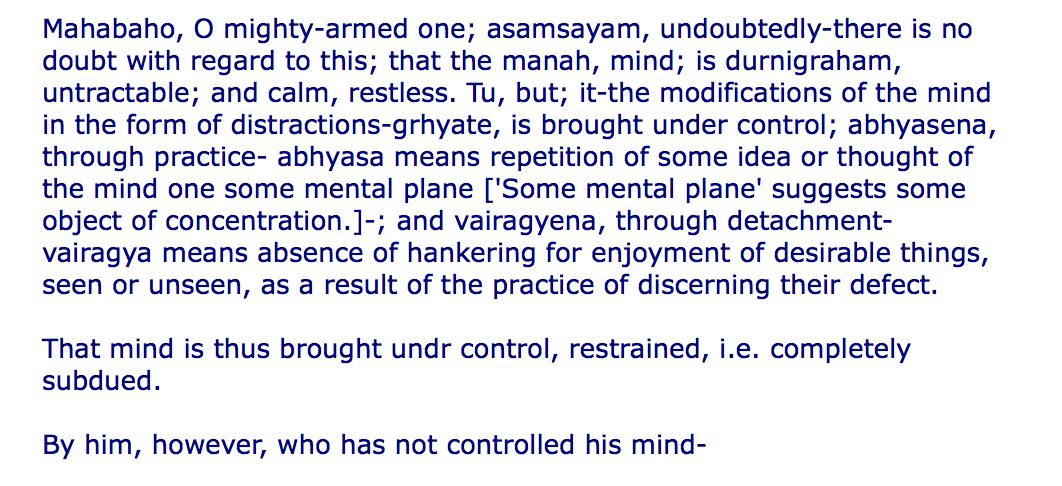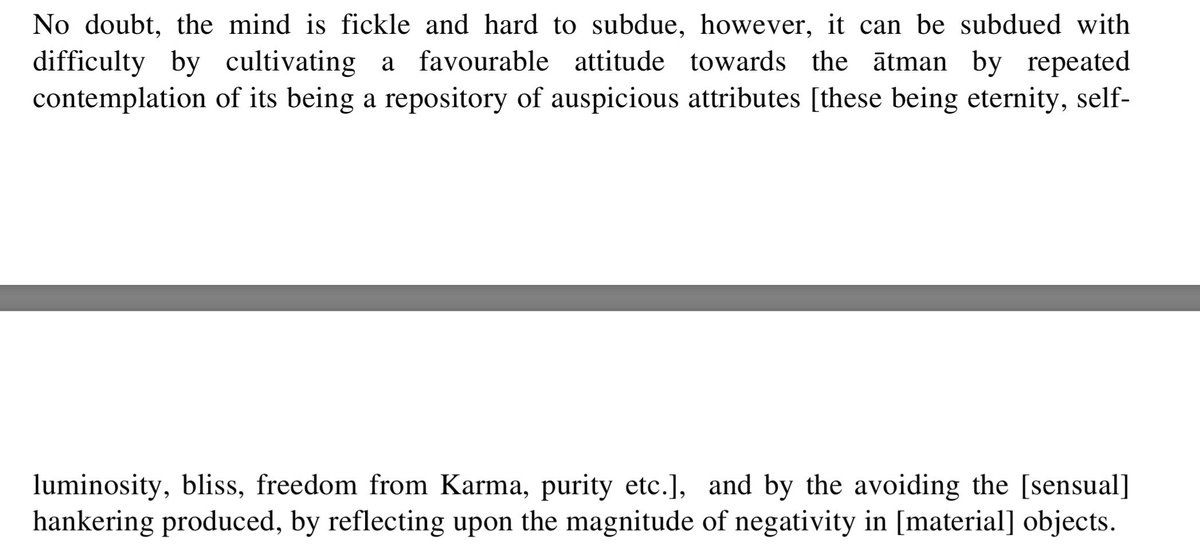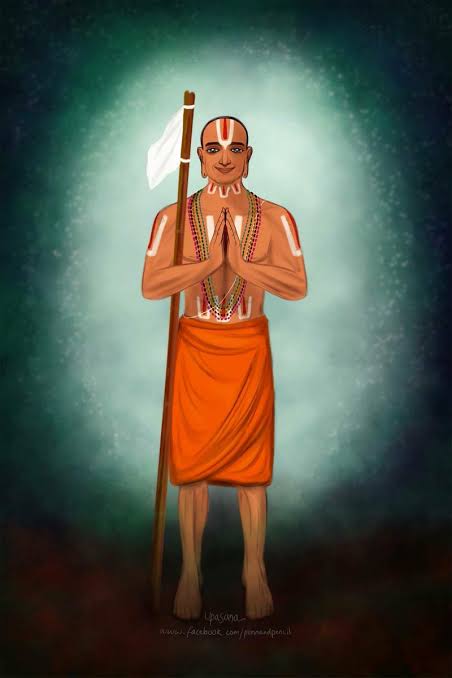Even when commentaries are preferred, it is usually those of Adi Śankara or Rāmānujā, or in some cases a new bhashya like that of the Gauḍīya Vaiṣṇava teacher - Prabhupāda
And the most widely cited
Yet while it is often eulogized, my personal observation is that there is a tendency to underrate later medieval commentaries.
Though Madhusūdana Sarasvatī was a man of many accomplishments, perhaps his greatest work is his commentary on the Gita - the Gudartha Dipika
With commentaries often running into several pages for a single verse!
He was a native of modern Bangladesh - who was born as Kamalanayana. His ancestral roots however were in Madhya Desha, with an ancestor named Rama Mishra Agnihotri migrating to Bengal from Kannauj in 11th century.
His "Advaita Siddhi" is a famous riposte to the Dwaita classic authored by Vyāsatīrtha - the scholar patronized by Vijayanagara Empire
So let's get an idea of the work by examining Madhusudana Saraswati's bhashya on a single Gita verse - Verse # 35 of Chapter 6 on Dhyana Yoga
असंशयं महाबाहो मनो दुर्निग्रहं चलम् ।
अभ्यासेन तु कौन्तेय वैराग्येण च गृह्यते ॥ ६-३५॥
"O Mighty armed one. It is doubtless that the mind cannot be controlled and is restless. But O' Sun of Kunti, it is restrained through Practice (abhyAsa) and Detachment (vairAgya)"
Sankara's bhashya for this is very brief. Here it is (Swami Gambhirananda translation - sankaracharya.org website)

Defining abhyAsa as repetition of some idea or thought (concentration)
Vairagya - as detachment that comes from an awareness of the defects of enjoying desirable things.
He stops at that
Here it is. (from srimatham.com website)

Not that different from Sankara's Bhashya. The major difference is that Ramanuja explains abhyAsa not merely as "concentration" on a thought, but as reflection on the auspicious attributes of self.
It runs into 6 pages in the English translation. He is thorough, meticulous, and uses two other texts extensively to explain this single verse -
The Laghu Yoga Vashishta
Patanjali Yoga Sutras
Let me summarize it the best I can
1. Why is the mind fickle and naturally uncontrollable
2. Can the mind be "violently" controlled the way we violently close our eyes, or close our ears etc? If not, what's the alternative?
(Contd..)
4. What exactly is abhyAsa. What does it entail to make it successful?
5. What is vairAgya? What are the different kinds of it?
"Why is the mind fickle"?
"Can it be controlled violently? If not what's the alternative"?
Now Sankara and Ramanuja took this to be axiomatic. And did not elaborate
Prārabdha karma - the accumulation of karmas from the past that are experienced through the present body
So there is a clear attribution
This may seem obvious. But Madhusudana spells it out -
The reason is - Unlike eyes or ears, the "locus" of the heart cannot be restrained.
This regular method is of course Yoga.
He backs himself by citing Yoga Vasishta passages - a text authored perhaps some 1000 years before Madhusudana Saraswati's own time
And used extensively by Madhusudana in his arguments
"Controlling the mind without Yoga is like controlling a wicked elephant without ankusha (the hooked goad used by the mahaout)"
Mastery of spiritual knowledge
Association with holy men
total giving up of desires
control of the movements of the vital force
"those who control mind violently when these means are available, are like people who reject a lamp and instead remove darkness using collegium (on their eyelashes)
A wonderful analogy
As per Yoga Vasishta, the "tree of the mind" has got two seeds -
a. vAsanA (the latent tendency to desire)
b. movement of the vital force
But Vasishta distinguishes between the two and prescribes different means to counter both
Movement of vital force is stopped through earnest practice of PraNAyAm, practice of Asana and control of food.
Whereas vAsana is controlled through dealings without attachment, shunning of worldly thoughts, and observation of the perishability of the body
It is abhyAsa that is needed to control "movement of the vital force"
vairAgya to control "vAsana"
So Madhusudana Saraswati here is linking what Krishna is saying about abhyAsa and vairAgya to the two "seeds" of the mind cited by Vasishta
"association with holy men"
"mastery of spiritual knowledge"
But then concludes - these two are helpful to abhyAsa and vairAgya - but non-essential
Hence Krishna sticks to abhyAsa & vairAgya
"abhyasa-vairagyabhyam tan-nirodhah"
Where Patanjali too agrees with Krishna in suggesting that these two are essential for Nirodha (stilling the mind)
"It is the state that is best understood as cessation - like a fire without fuel stops burning"
Cessation of Fire without fuel - an apt way of explaining the goal being sought here.
Are abhyAsa and VairAgya both needed? Are they somehow related to each other? Or independent.
Madhusudana again uses a remarkable analogy to explain why both are essential, and somewhat independent means
"The river of the mind flows both ways (unlike earthly rivers) - one flows towards good, and one flows towards evil
Whereas the current that is flowing towards the good can be augmented by constructing a canal of sorts and channeling it - think of this as "AbhyAsa"
A brilliant analogy yet again
E.g. You can make the sacrificial cake using either paddy or barley - that's an option.
But here abhyAsa vs vairAgya is not an option. You need both.
Madhusudana goes into specifics here. And again cites Patanjali!
Sutra # 14 Chapter 1
Sa-Tu-Dirghakala-Nairantarya-Satkara-Asevitah-Drdhbhumih
1. It is fully adhered to without despondency (asevitah)
2. Adhere to for a long time (dIrgha kalah)
3. Adhered to without a break (nairantarya)
4. Adhered to with confidence (satkAra)
And now you have Madhusudana using Patanjali's arguments, 1000+ years later!
And its intellectual history is in constant development throughout that period from mid 1st millennium BCE to mid 2nd millennium CE
VairAgya as per Madhusudana is of two types - para (supreme) and apara (relative)
So he is a realist here, who doesn't give an absolute definition of vairAgya
yatamAna (engaged in effort to abjure the non-essential)
vyatireka (exclude the non-essential through discrimination)
ekendriya longing for non-essential remains just a longing in mind)
vashIkAra (complete absence of desire)
It stems from desirelessness for the guNas, which in terms from the direct vision of the Purusha (the absolute divine being)
But Madhusudana while discussing these somewhat abstruse ideas, also finds time to explain the less important words used by Krishna in the verse
One such word is "mahAbAho" (mighty armed)
He cites the example of Arjuna fighting Shiva himself during his years in exile - a very well known episode also memorialized by Bharavi in his mahAkAvya - kirAtArjuniya
I particularly liked this tidbit. Notice how he has the eye for detail and trivia amidst all the philosophizing on the more abstruse parts of the verse.
Illustrating the richness of the work. A very underrated work which ought to be read by more
Bhashyas that in some respects excel the early bhAshyakAras
Gambhirananda interestingly like Madhusudana was a native of Bangladesh, and served as the 11th president of RK Mission. Died in 1988
As I said, he was a native of Bengal and his life largely overlapped with that of Akbar in 16th cen
But his ancestors were migrants from Kannauj in late 12th cen (not 11th as stated erroneously earlier)
However he never got the opportunity to meet the great man
But the more he attempted to marshal his arguments against Advaita, the more he got convinced by it leading to a conversion of sorts
And the law exempted the Muslim priests from punishment
Akbar was perturbed and encouraged Saraswati to found a new sect of armed Hindu SannyAsins who will also be outside the purview of legal action
Therein lies the origins of Naga sect of sannyAsins
"The Organization of the sannyAsins of Vedanta"
And both lived in Benares arguably at the same time
(Contd..)
For those who are conversant in Sanskrit here's the original text of the Bhashyas of Sankara, Ramanuja AND Madhusudana Saraswati on this particular Chapter 6 verse
gitasupersite.iitk.ac.in/srimad?languag…













